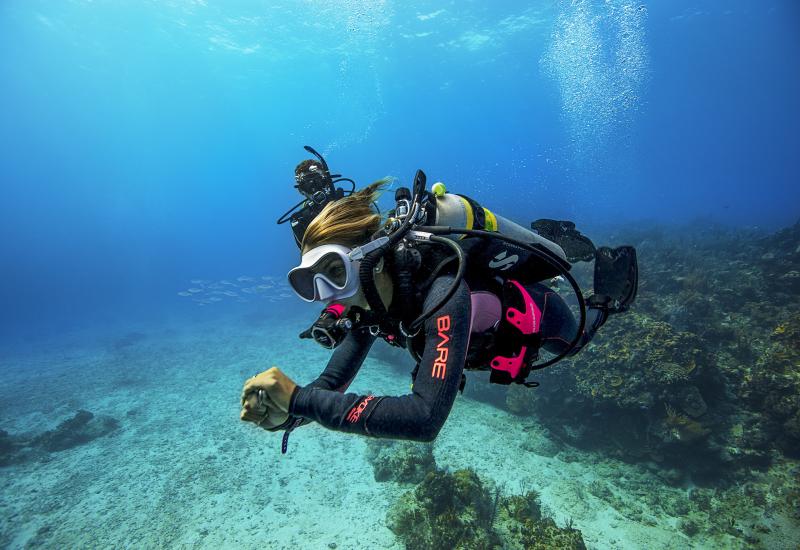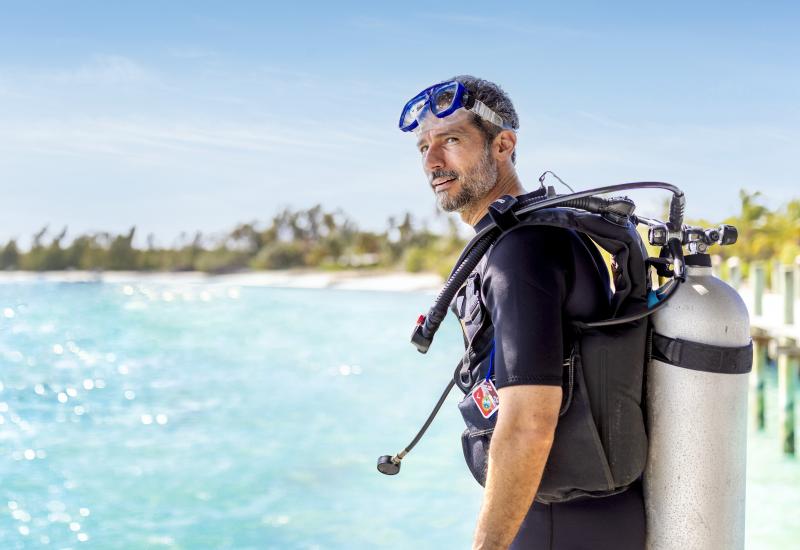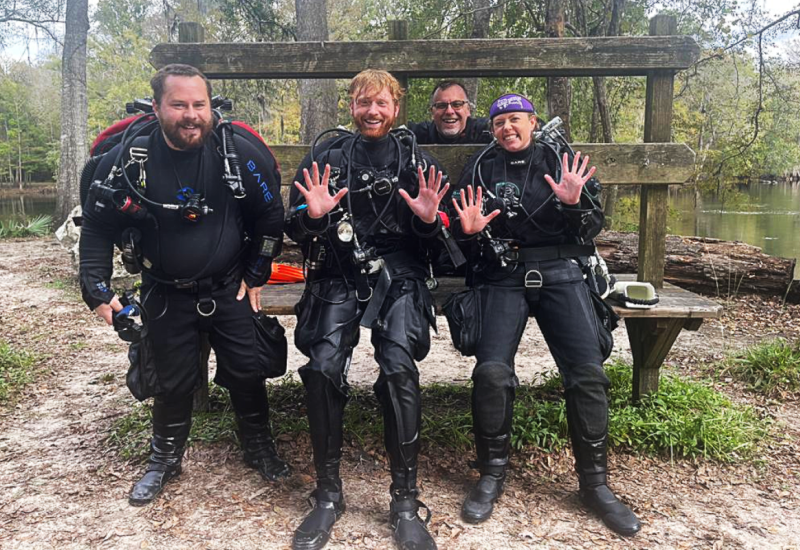Make the Most of Every Tank

How can you be sure your tank has enough gas to complete the dive you want to make?
December 2004
By Michael Ange
Photography by Mitch Mandel
Plan your dive and dive your plan--for most recreational divers this means checking your no-decompression status and perhaps reviewing communications and a route with your buddy. That's all well and good, but it leaves out the real limiting factor of most dives--your gas consumption. How can you be sure your tank has enough gas to complete the dive you want to make?
Well-trained technical divers don't even think of entering the water without first running the numbers to ensure they have an adequate gas supply for their complex dive plans. But the process can also help recreational divers who never venture beyond 130 feet.
Think about it: How many group dives end early because one diver ran low on air? How many divers surface ahead of the group, ending a dive for both buddies in the team because of insufficient gas supply? How many divers fail to reach the objective of a recreational dive for the same reason? The process of planning and monitoring your gas consumption is simple and only takes about 10 minutes of dive time and three minutes with a calculator.
Know Your SCR
The process starts with knowing your Surface Consumption Rate (SCR), a measure of how much gas you normally breathe on a typical dive. If you know your consumption rate, the planned depth and the duration of the dive, you can quickly calculate how much gas you'll likely use. Here's how it works:
Wearing a standard aluminum 80 rated to 3,000 psi, drop to a set depth (we'll use 33 feet seawater for simplicity), and record your starting tank pressure. Now swim at an average pace for 10 minutes while maintaining that depth. When the time is up, record the ending tank pressure. Subtract the end pressure from the start pressure to get the total gas used in psi. If you started with 2,700 psi and finished with 2,100 psi, you have used 600 psi.
Now adjust that usage to reflect surface pressure. First, convert the depth of the dive to pressure in atmospheres absolute (ATA) by dividing by 33 and adding one (33/33 + 1= 2 ATA). Then divide the total gas used by the pressure of the dive in ATA. (600 psi used/2 ATA = 300 psi). Now divide by the number of minutes in your swim for your SCR (300 psi/10 minutes = 30 psi per minute).
Using Your SCR
If you always use an aluminum 80, you now have enough information to plan gas consumption for any dive. Simply find the pressure in ATA of your maximum dive depth and multiply it by your SCR to find out how many psi per minute you will use.
Say you're planning a dive to a wreck at 100 feet and want to be sure you have enough gas to stay on the bottom as long as the no-deco times allow: 25 minutes by the U.S. Navy tables. (For deeper dives you should always plan to use the rule of thirds to manage your gas supply--one-third of your gas supply to swim away from the entry point or anchor line, one-third to get back to the anchor line and keeping one-third in reserve for any delays, your ascent and a safety stop.)
First, convert your planned maximum depth to ATA (100 feet/33 + 1 = 4.03 ATA). Now multiply the pressure at depth times your SCR (4 ATA x 30 psi per minute = 120 psi per minute).
If you follow the rule of thirds, you should arrive at the anchor line to begin your ascent with 1,000 psi remaining in your tank. That means you have 2,000 psi to explore the wreck. So: 2,000 psi/120 psi per minute = 16.6 or approximately 17 minutes.
Remember that this calculation is based on a moderate-work SCR. If you're likely to be kicking a lot or fighting a current, you'll need to use a higher SCR. You can find this heavy-work SCR by repeating the swim exercise at a strenuous rate. In order to maintain a constant effort, it may help to push against the side of a pool or against a dive platform. To get an accurate measure, try to swim at the strenuous rate for at least two minutes--five minutes if you can stand it. Just be sure to accurately record your beginning and ending tank pressures and to divide by the appropriate amount of time.
Different-Sized Cylinders
Once you start calculating air consumption, you may find that the aluminum 80 is not the best cylinder for you or for a specific dive. If you arrive on the boat and find that they use steel 98 tanks, for example, you'll need to take this calculation one step further.
To adjust your dive planning to any cylinder size, you simply need to convert your SCR to another measurement called a Respiratory Minute Volume (RMV).
To make this conversion, you first need to determine how much gas, in cubic feet, is used every time the SPG drops 1 psi in the cylinder you used for your SCR calculation. We accomplish this by dividing the rated pressure of the tank into the rated volume of the tank. (Note: For this calculation, remember to use the rated pressures and volumes stamped into the metal near the top of the cylinder, not the pressure you read on your gauge.)
For your aluminum 80 rated to 3,000 psi: 80 cubic feet/3,000 psi = .0267 cubic feet in every psi. Now multiply this number by your SCR. (30 x .0267 = .8 cubic feet per minute.) Your surface RMVa€?is .8 cubic feet per minute.
Now you can use the RMV to compare the difference between the aluminum 80 and the steel 98 in order to see which would be most useful for the 100-foot wreck dive following the rule of thirds. At the maximum depth of 100 feet, our diver will use 3.2 cubic feet per minute (.8 cubic feet per minute x 4 ATA = 3.2).
For the aluminum 80: 80 cubic feet/3 = 26.6 cubic feet. Our diver can use about 26 cubic feet out and 26 cubic feet back to the anchor line or 52 cubic feet prior to ascent. If the RMV at depth is 3.2, that gives him about 16 minutes of bottom time (52 cubic feet/3.2 cubic feet per minute = 16.25 minutes of bottom time).
For the steel 98: 98 cubic feet/3 = 32.67 cubic feet. Our diver can use 65.3 cubic feet of gas prior to ascent. At the 3.2 RMV at depth, that gives him about about 20 minutes of bottom time (65.3 cubic feet/3.2 cubic feet per minute = 20.4 minutes).
Precise Planning
So far, we've used SCRs and RMVs to see if an existing cylinder has enough air to make a given dive. You can also work the problem in reverse to calculate how much gas you will need and then select the appropriate cylinder to achieve your objectives.
So how much air would you need to spend the entire 25 no-deco minutes at depth on the shipwreck and still dive by the rule of thirds?
We already know our RMV at depth is 3.2 cubic feet per minute (4 ATA x .8 RMV = 3.2 RMV at depth).
Now multiply the RMV at depth by the maximum no-deco time (3.22 x 25 minutes = 80.5 cubic feet). If our diver is properly using the rule of thirds, that 80 cubic feet equates to two-thirds of the total required gas supply, so this diver would need another 40 cubic feet or a 120 cubic-foot cylinder to make the dive as planned.

How can you be sure your tank has enough gas to complete the dive you want to make?
December 2004
By Michael Ange
Photography by Mitch Mandel
Plan your dive and dive your plan--for most recreational divers this means checking your no-decompression status and perhaps reviewing communications and a route with your buddy. That's all well and good, but it leaves out the real limiting factor of most dives--your gas consumption. How can you be sure your tank has enough gas to complete the dive you want to make?
Well-trained technical divers don't even think of entering the water without first running the numbers to ensure they have an adequate gas supply for their complex dive plans. But the process can also help recreational divers who never venture beyond 130 feet.
Think about it: How many group dives end early because one diver ran low on air? How many divers surface ahead of the group, ending a dive for both buddies in the team because of insufficient gas supply? How many divers fail to reach the objective of a recreational dive for the same reason? The process of planning and monitoring your gas consumption is simple and only takes about 10 minutes of dive time and three minutes with a calculator.
Know Your SCR
The process starts with knowing your Surface Consumption Rate (SCR), a measure of how much gas you normally breathe on a typical dive. If you know your consumption rate, the planned depth and the duration of the dive, you can quickly calculate how much gas you'll likely use. Here's how it works:
Wearing a standard aluminum 80 rated to 3,000 psi, drop to a set depth (we'll use 33 feet seawater for simplicity), and record your starting tank pressure. Now swim at an average pace for 10 minutes while maintaining that depth. When the time is up, record the ending tank pressure. Subtract the end pressure from the start pressure to get the total gas used in psi. If you started with 2,700 psi and finished with 2,100 psi, you have used 600 psi.
Now adjust that usage to reflect surface pressure. First, convert the depth of the dive to pressure in atmospheres absolute (ATA) by dividing by 33 and adding one (33/33 + 1= 2 ATA). Then divide the total gas used by the pressure of the dive in ATA. (600 psi used/2 ATA = 300 psi). Now divide by the number of minutes in your swim for your SCR (300 psi/10 minutes = 30 psi per minute).
Using Your SCR
If you always use an aluminum 80, you now have enough information to plan gas consumption for any dive. Simply find the pressure in ATA of your maximum dive depth and multiply it by your SCR to find out how many psi per minute you will use.
Say you're planning a dive to a wreck at 100 feet and want to be sure you have enough gas to stay on the bottom as long as the no-deco times allow: 25 minutes by the U.S. Navy tables. (For deeper dives you should always plan to use the rule of thirds to manage your gas supply--one-third of your gas supply to swim away from the entry point or anchor line, one-third to get back to the anchor line and keeping one-third in reserve for any delays, your ascent and a safety stop.)
First, convert your planned maximum depth to ATA (100 feet/33 + 1 = 4.03 ATA). Now multiply the pressure at depth times your SCR (4 ATA x 30 psi per minute = 120 psi per minute).
If you follow the rule of thirds, you should arrive at the anchor line to begin your ascent with 1,000 psi remaining in your tank. That means you have 2,000 psi to explore the wreck. So: 2,000 psi/120 psi per minute = 16.6 or approximately 17 minutes.
Remember that this calculation is based on a moderate-work SCR. If you're likely to be kicking a lot or fighting a current, you'll need to use a higher SCR. You can find this heavy-work SCR by repeating the swim exercise at a strenuous rate. In order to maintain a constant effort, it may help to push against the side of a pool or against a dive platform. To get an accurate measure, try to swim at the strenuous rate for at least two minutes--five minutes if you can stand it. Just be sure to accurately record your beginning and ending tank pressures and to divide by the appropriate amount of time.
Different-Sized Cylinders
Once you start calculating air consumption, you may find that the aluminum 80 is not the best cylinder for you or for a specific dive. If you arrive on the boat and find that they use steel 98 tanks, for example, you'll need to take this calculation one step further.
To adjust your dive planning to any cylinder size, you simply need to convert your SCR to another measurement called a Respiratory Minute Volume (RMV).
To make this conversion, you first need to determine how much gas, in cubic feet, is used every time the SPG drops 1 psi in the cylinder you used for your SCR calculation. We accomplish this by dividing the rated pressure of the tank into the rated volume of the tank. (Note: For this calculation, remember to use the rated pressures and volumes stamped into the metal near the top of the cylinder, not the pressure you read on your gauge.)
For your aluminum 80 rated to 3,000 psi: 80 cubic feet/3,000 psi = .0267 cubic feet in every psi. Now multiply this number by your SCR. (30 x .0267 = .8 cubic feet per minute.) Your surface RMVa€?is .8 cubic feet per minute.
Now you can use the RMV to compare the difference between the aluminum 80 and the steel 98 in order to see which would be most useful for the 100-foot wreck dive following the rule of thirds. At the maximum depth of 100 feet, our diver will use 3.2 cubic feet per minute (.8 cubic feet per minute x 4 ATA = 3.2).
For the aluminum 80: 80 cubic feet/3 = 26.6 cubic feet. Our diver can use about 26 cubic feet out and 26 cubic feet back to the anchor line or 52 cubic feet prior to ascent. If the RMV at depth is 3.2, that gives him about 16 minutes of bottom time (52 cubic feet/3.2 cubic feet per minute = 16.25 minutes of bottom time).
For the steel 98: 98 cubic feet/3 = 32.67 cubic feet. Our diver can use 65.3 cubic feet of gas prior to ascent. At the 3.2 RMV at depth, that gives him about about 20 minutes of bottom time (65.3 cubic feet/3.2 cubic feet per minute = 20.4 minutes).
Precise Planning
So far, we've used SCRs and RMVs to see if an existing cylinder has enough air to make a given dive. You can also work the problem in reverse to calculate how much gas you will need and then select the appropriate cylinder to achieve your objectives.
So how much air would you need to spend the entire 25 no-deco minutes at depth on the shipwreck and still dive by the rule of thirds?
We already know our RMV at depth is 3.2 cubic feet per minute (4 ATA x .8 RMV = 3.2 RMV at depth).
Now multiply the RMV at depth by the maximum no-deco time (3.22 x 25 minutes = 80.5 cubic feet). If our diver is properly using the rule of thirds, that 80 cubic feet equates to two-thirds of the total required gas supply, so this diver would need another 40 cubic feet or a 120 cubic-foot cylinder to make the dive as planned.










